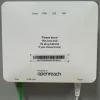RECORD A Single Laser and Cable Delivers Fibre Optic Speeds of 43Tbps
A team of scientists working at the Technical University of Denmark (DTU) has broken a new record after they were able to use a single laser to transmit data speeds of 43Tbps (Terabits per second) over a single fibre optic cable, which is important because this kind of setup is arguably reflective of a real-world environment.
Plenty of teams around the world have demonstrated faster transmissions over fibre optic communications before, such as last year’s test by a Southampton team that found a way to push data at close to the true speed of light by using a hollow fibre optic cable to deliver 73.7Tbps (here). But most of those have used either several fibres / different types of cables, multiple lasers or struggled over distance (sometimes all three).
Advertisement
As usual the best solution is always one that can be used with existing network infrastructure, which is why BT’s recent demo of a 1.5Tbps link in the United Kingdom (here) and Alcatel-Lucent’s transmission of 31Tbps over a single fibre optic cable (here) is so important. You can perform all sorts of wizardry with the light spectrum (e.g. twisting it into a vortex, using each colour for a new data channel etc.) but if it’s not easy to implement then the costs of upgrade can spiral.
Happily the High-Speed Optical Communications (HSOC) team at DTU Fotonik claims to have broken “another world record” by transferring an astonishing 43Tbps using just a single laser in the transmitter for a single fibre. One slight downside though is that in order to achieve this they “borrowed” a new type of optical fibre from the Japanese telecoms firm NNT.
Apparently this type of fibre contains seven cores (glass threads) instead of the single core used in standard fibres, which makes it possible to transfer even more data. Despite the fact that it comprises seven cores, the new fibre does not take up any more space than the standard version. Never the less it would add some cost if you wanted to upgrade.

Advertisement
The official press release doesn’t say much and so we had to do a little digging, which soon revealed the above illustration and that the achievement had first been announced on 3rd July 2014 and used a 67km long fibre. But even then the details on this demo are hard to come by.
Professor Leif Oxenløwe of DTU Fotonik said:
“We have used all the known, neat tricks that exist nowadays to make data in five dimensions: time, frequency, polarization, quadrature and space.”
Japanese telco NTT has worked with DTU before and in 2012 they combined with others to demonstrate an ultra-large capacity transmission of 1 Petabit per second (1000 Terabits) over a 52.4km length of 12-core (light paths) optical fibre (here), although it’s not clear how the laser setup was arranged.
Until recently multi-core fibres were more expensive to make but they have become a lot cheaper, although the upgrade requirements mean that such cables would currently only be of use in new international or national deployments rather than to replace existing cables (no reason to do that as there’s still potentially many decades of life in single fibres, such as those used for FTTH).
Never the less it’s good to see such developments, especially with the IEEE working towards a new 1Tbps Ethernet standard and many broadband ISPs in the United Kingdom already moving data at speeds of above 1Tbps.
Advertisement
Mark is a professional technology writer, IT consultant and computer engineer from Dorset (England), he also founded ISPreview in 1999 and enjoys analysing the latest telecoms and broadband developments. Find me on X (Twitter), Mastodon, Facebook, BlueSky, Threads.net and Linkedin.
« UPD Citizens Advice Slam UK Debt Collection for Broadband Cancel Fees


















































Comments are closed